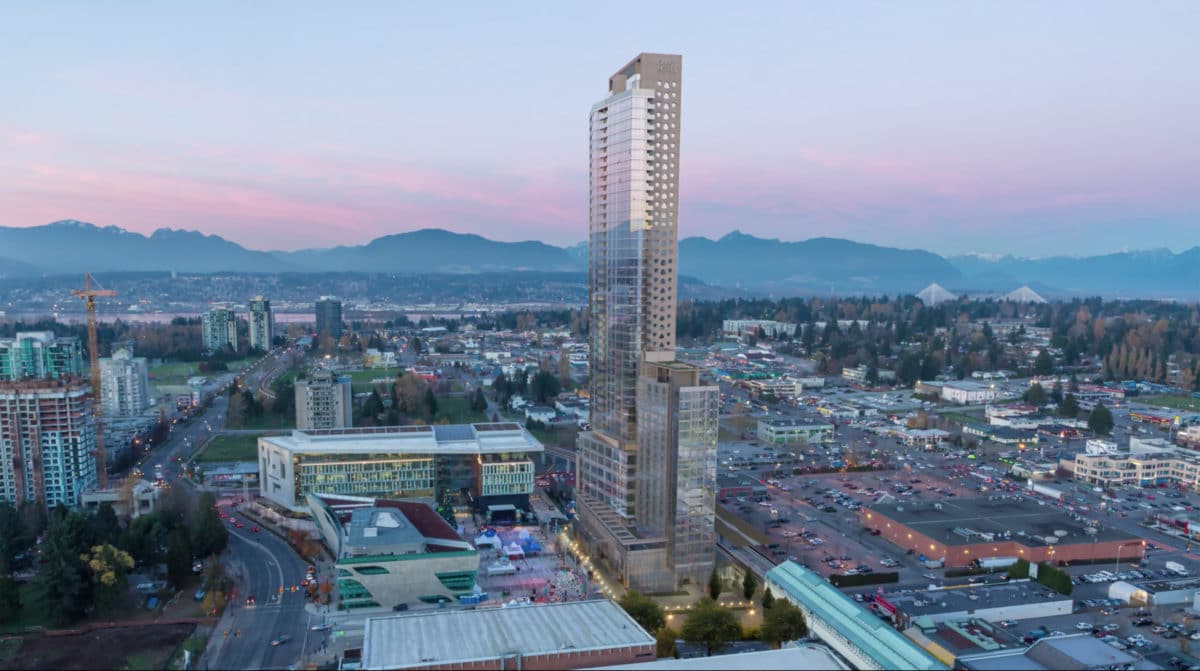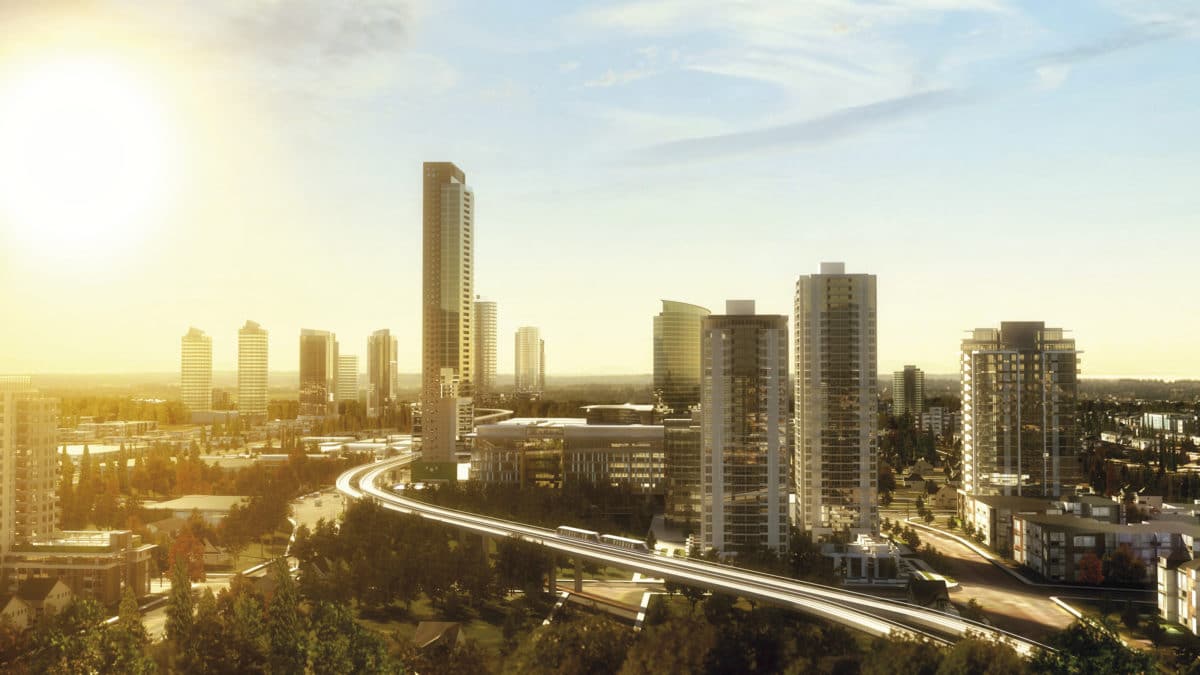
[Rendering: Courtesy of ZGF Architects]
Surrey city developers in British Columbia envisioned a thriving downtown framed around a landmark building when they set out to bring 3 Civic Plaza to life by the end of 2017.
The 52-story project designed by ZGF Architects in partnership with Century Group and Surrey City Development Corporation features more than 300 residential suites, a Marriott hotel, Kwantlen Polytechnic University’s urban campus, a rooftop garden, a modern fitness center, and more. The project’s estimated total cost is $175 million CAD. Construction began in May 2014 and was scheduled to be complete in December 2017.
With its sustainable elements, towering height, and many uses, the project team says this building is truly ahead of its time. The ZGF team faced the project’s complexity head on, setting a new standard for inventive design focused on sustainability and improving human comfort with features like passive natural ventilation and a hydronic heating and cooling system. “3 Civic Plaza required us to take more risks to build an aggressive and complex building,” says Patrick Cotter, architect and managing partner of ZGF’s Vancouver office.

[Rendering: Courtesy of ZGF Architects]
The Challenges
Cotter says the challenging market in Surrey affected ZGF’s design process. 3 Civic Plaza had to perform well financially and compete on cost with other local developments, while its building costs were higher and its goals were loftier. The team had to rely on economical and inventive design.
For instance, when designing the building’s structure, Cotter knew ZGF couldn’t use a rigid core design typical of other concrete residential towers. “If we approached the building with a rigid core design, that would also be a third of our construction budget,” he says. “And vertical circulation in one core would have eaten up the floor area, making the building very inefficient.”
So Cotter and his team brainstormed other options for the building’s vertical composition. “We had to accommodate for different occupancies in an efficient way where no space’s needs were compromised by the other,” he says. ZGF chose a concrete shear wall frame to externally support the building. It cost less than the conventional approach, and the 2-foot thick frame allows for individual structural grids for both public and residential areas, as well as exit stairs. This frame ultimately became a signature part of 3 Civic Plaza, with a guitar pick–shaped window in the shear wall frame that makes for a very striking design.
Stack effect proved to be another challenge. The traditional approach to combating stack effect is blowing air downward through the building by using fans, or creating undercuts in doors to draw in air from the hallway so residents do not suffocate in their suites. ZGF strived to use an innovative ventilation process to offer the most comfortable experience. “Our goal was to give every resident access to fresh air,” Cotter says. “Instead of fans blowing air, we wanted to bring in fresh air from outside and use stack effect to let the air exhaust.”
Many architects refrain from using this ventilation method because vertical shafts take up square footage. But harnessing stack effect eliminates the need for many fans and improves the air quality by taking in fresh air. By using a tenth of the usual amount of fans and equipment, 3 Civic Plaza’s airflow system saves energy and money, too.

[Rendering: Courtesy of ZGF Architects]
More Benefits
ZGF included a hydronic heating and cooling system to help cut down on long-term energy costs, increase energy efficiency, and make the living environment more comfortable. The building uses radiant heating and cooling from the ceiling instead of the floor. This feature—unlike traditional AC—allows for heat recovery at the top of the building that can be transferred to provide heat to other areas or even the swimming pool.
The ZGF team used an intuitive design approach, basing their decisions on first human instincts to increase the feeling of comfort and convenience. Even if the temperature outdoors is the same as indoors, our first instinct to cool off is to open a window, for example. “We decided to provide operable windows because air movement is proven to help people feel cooler and better,” Cotter says. Operable windows, controllable roller blinds, and passive natural ventilation act as solutions to western heat exposure. Occupants maintain control over their living environment without having to rely on fans or other energy consuming alternatives to cool down.
To fully understand the living and working environment of the building, ZGF uses virtual reality walkthroughs. Evolved directly from a digital design model, these 3D environments allow designers and clients to experience the building in real time. Renderings become than just conceptual tools for visualization for marketing purposes—they’re an inherent part of the design process. All of ZGF’s renderings and models are done in-house. While the rendering itself is still a 2D experience, ZGF also uses 3D-printed models and houses a physical model shop in their office. By utilizing renderings throughout the process, ZGF extracts information about the building and its performance along the way.
3 Civic Plaza is a distinct landmark building whose design depended upon research and analysis. Informed by market and financial challenges, ZGF redefines the boundaries of innovative design. “When we take risks in building and design, it is never trial and error,” Cotter says. “We prove the risks will pay off in advance through in depth analysis facilitated by digital design.”

